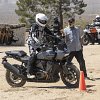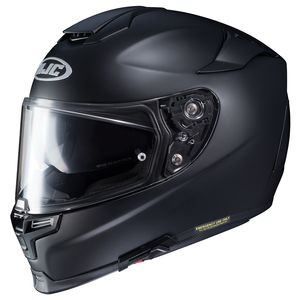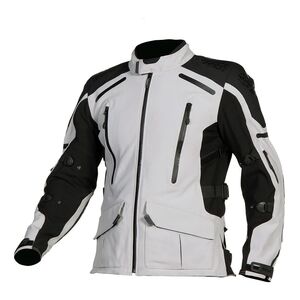Off-road bragging rights are important to ADV buyers, but let’s face it: One thing adventure-touring motorcycles have in common with Land Rover Defenders and Mercedes G-wagons is that most of them spend far more time on paved highways and city streets than muddy roads to remote deer camps.
Maybe that’s why Harley-Davidson invited a few off-road lightweights (I was one of them) to ride their first-ever adventure-touring motorcycle at Jim Hyde’s "Zakar" event center in the Mojave Desert, about 100 miles north of Los Angeles, in addition to having guys like Spurgeon test the Pan America 1250. (If you haven’t read Spurgeon’s review, you should, because a) it’s better and b) I am going to try not to repeat stuff he covered in detail.) For us road riders, we had a day of off-road instruction from the RawHyde team followed by a street and off-road ride the next day.
Buyers of $20,000+ motorcycles skew older. Harley-Davidson staff told us that when they surveyed their existing customers, they learned many already have an ADV bike, and as a corollary, ADV owners often have one or more other bikes, too. That squares with the ADV riders in my circle of friends.
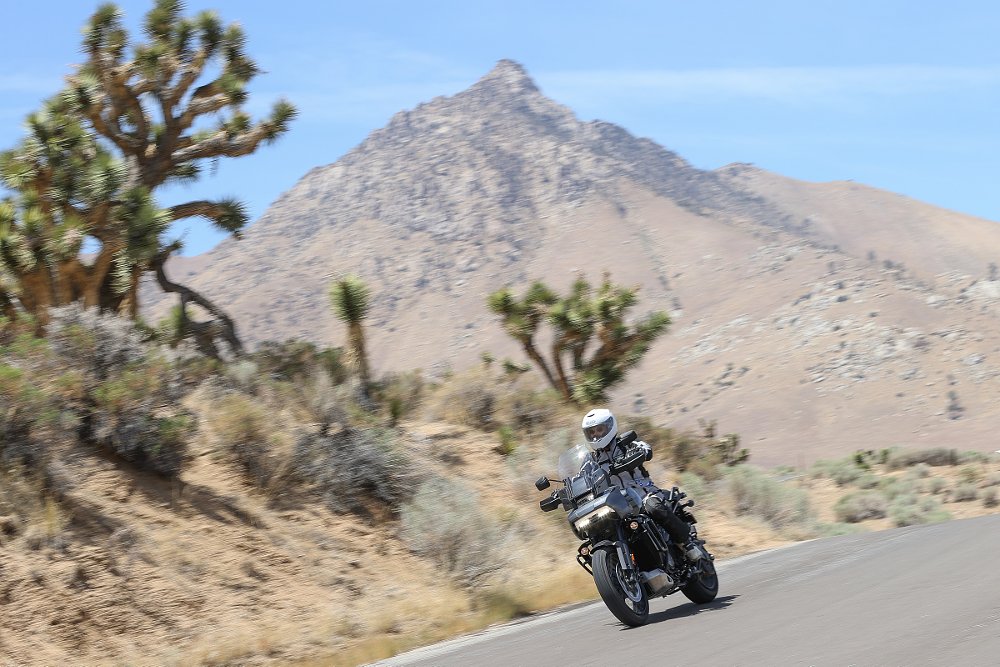
They own multiple bikes but accumulate most of their mileage on big BMW GS models, Ducati Multistradas and Honda Africa Twins. Most of them are tall (read that phrase either way, referring to my friends or their bikes). After years sport-touring in the Ozarks and Rockies, low handlebars and rearset pegs finally took a toll on wrists, shoulders, knees and backs. Now, they sport-tour on adventure bikes with road-biased tires.
I get it. I love riding those bikes too. My problem is that with a 30-inch inseam, I hate bringing them to a stop. I’m not the only person with that complaint and Harley’s market research confirmed it, which is why the high-end Pan America 1250 Special model can be had with optional Adaptive Ride Height that lowers the bike almost 1.5 inches when it comes to a stop. I can’t believe it took this long for a manufacturer to invent it.
So I’m the right age. I’m inclined towards sport-touring and café racing, or at least riding from café to café. I have occasional Baja fantasies but I’m intimidated by the seat heights of contemporary ADVs. Except for qualifying for the loan, I’m pretty much the ideal target customer for the top-of-the-line Pan America with ARH.
What about you? If you’re not young, big and strong, with lots of adventure rally and enduro experience, a la Spurgeon, here's a road rider's take on the Pan America.
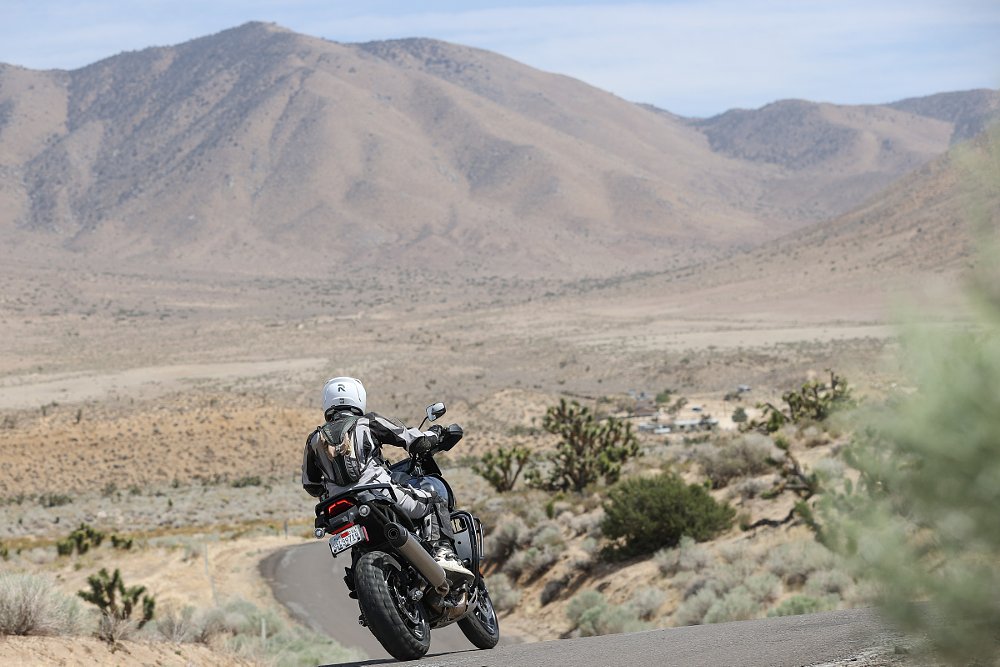
Pan America on the road (and beyond)
On the road, the Revolution Max 1250 proves aptly named. At idle, the 60-degree V angle and 30-degree crank offset made it sound a bit like a Ducati. That impression continued once underway. Our ride began with a few miles of divided highway. At about 4,000 rpm (about half-way to peak power) I could feel the vibration that the engineers had put back into the motor, but I get it; it’s just enough to remind you that something’s happening down there. H-D techs had installed the rubber footpeg inserts, but I doubt they were needed. For the street ride, my bike was fitted with the more road-biased standard-equipment tire, a dual-compound (and dual-branded) Harley-Davidson/Michelin Scorcher Adventure.
The peak horsepower and torque are, as Harley’s Paul James put it, pretty much table stakes in the category. But thanks to computer-controlled variable valve timing that can alter cam timing through a stunning 40 degrees, the bike makes a broad spread of power that begins very low in the rev range. That’s almost as nice to have on asphalt as it is on dirt. We got into some twisty and technical roads where I found myself leaving it in third or fourth gear for miles at a time. If a turn proved tighter than expected, the motor was quite happy to pull from two grand. That said, if you want to ride it like a sport bike, it’s a beast from about 6,500 rpm to the 9,500 rpm redline. In case you’re wondering about top speed, the Pan America is digitally governed to 135 mph. (No, I didn’t run it up there to feel the system apply a limiter.)
I regretted bringing only full-on motocross boots that made shifting a bit of a pain. Despite my clumsy inputs, the six-speed box gave me a few "Wait, is this a Harley?" moments as it snicked up or down in (dare I say it?) Japanese fashion. Shift quality may be enhanced because there are compensation springs in the primary gear to smooth out power pulses before they reach the tranny.
Downshifting and trail-braking into corners, the bike was confidence-inspiring. Harley’s presentation mentioned that the cable-actuated clutch has a slipper function, but the "Cornering-Enhanced Drag Torque Slip Control" (DTSC) system takes that a step further; the computer actually sends a torque request to the motor to minimize wheel hop on corner entry.
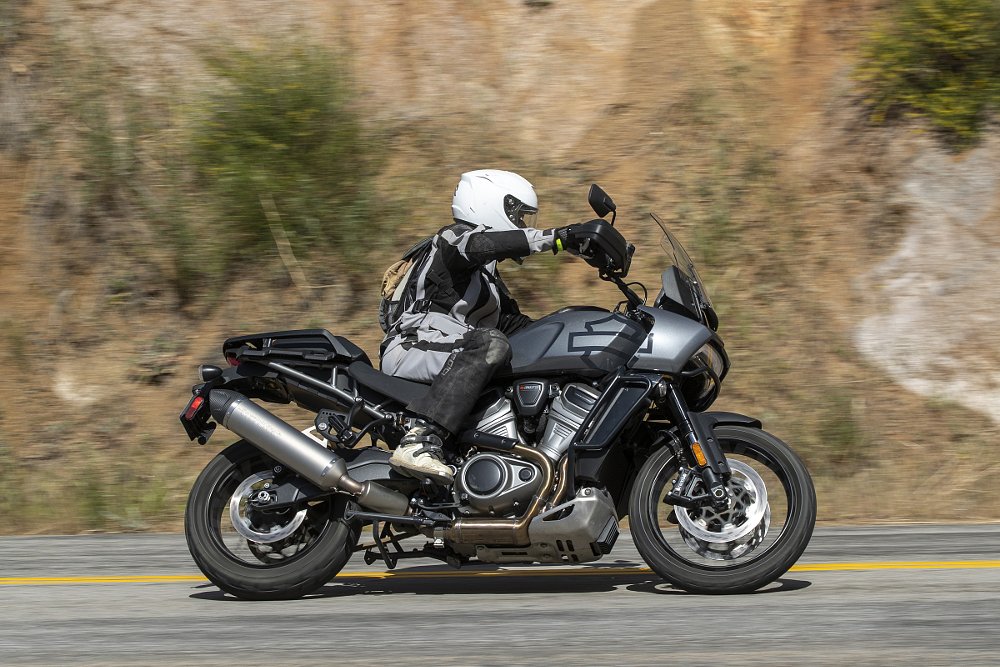
I started out in Road mode but switched to Sport mode as we got to interesting roads. I noticed that it stalled on me a couple of times in the middle of slow U-turns for photo passes, which seemed strange because the bike trundled along happily with no throttle input at all the previous day when we all got an abbreviated version of RawHyde’s ADV beginner course. (I should have tried switching to Off Road mode for those slow maneuvers, but that didn’t occur to me until I was on the plane home.)
Overall, the on-road experience of the Revolution Max 1250 made me sad that the Bronx was shelved, though at least we have the Sportster S and the promise of more models to come using this engine.
They say that a man with two watches never knows exactly what time it is, and I’ve always thought a rider with fully adjustable suspension is never really certain he or she’s on the right settings, either. The Pan America Special eliminates uncertainty because it’s got hella sophisticated suspension, which combines Showa hardware and H-D software.
Preload is automatically and continuously adjusted for the total rider/passenger/fuel/luggage load, to yield about 2.5 inches of sag at each end. Damping is also continuously adjusted for the conditions and the way you’re riding. In the presentation, engineers and execs focused on the off-road benefits of this system, but it also results in great road manners. (This is a "semi-active" system, which differentiates it from some high-end, fully active automotive systems that actively push back to keep cars level in turns.)
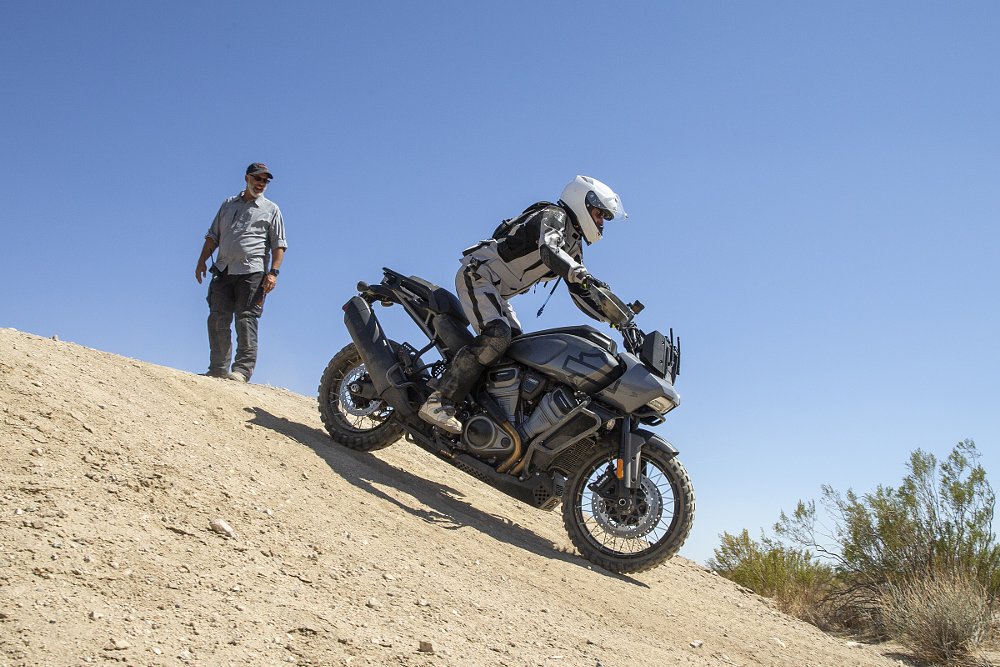
The basic steering geometry is roughly in the middle of the models Harley benchmarked against. I felt that the handling was slightly heavier than the "let’s-harry-the-crotch-rockets" handling of, say, the KTM 1290 Super Adventure S. But there’s a proviso: For our dirt training, our Pan Americas were fitted with Michelin Anakee Wild DOT knobbies (available at H-D dealers) and the optional spoked wheels. Although they changed over to stock tires for our second day, they kept the spoked wheels, which are 14 (!!) pounds heavier than the standard cast alloy wheels.
I didn't have the chance to compare the Pan America on the different wheels, but in the past when I’ve switched to lighter wheels, the effect is transformative on handling, braking and acceleration. Harley-Davidson says the cast wheels are suitable for groomed gravel or dirt roads. If you take one piece of my advice to heart, it’s this: Don’t pay hundreds of dollars more for heavier laced wheels unless you plan on giving Spurgeon a run for his money off-road. If, like most buyers, you’ll spend 95 percent of your time on asphalt with an occasional short gravel run into your campsite or whatever, you’ll much prefer the on-road handling of the 14-pound lighter cast wheels.
Personally, I'd also like to see Harley-Davidson create an ST version with belt drive, to eliminate those motel parking lot chain adjustments.
On the subject of mid-trip maintenance, I’ll point out that the most interesting roads are often far from big cities. My Multistrada and GS-riding friends tell stories of breakdowns occurring hundreds of miles from the nearest Ducati or BMW dealer. Harley-Davidson’s dealer network in the United States is far larger than either of those Euro brands, with coverage in hundreds of smaller cities and towns. For some riders, that will be another factor in the Pan America's favor.
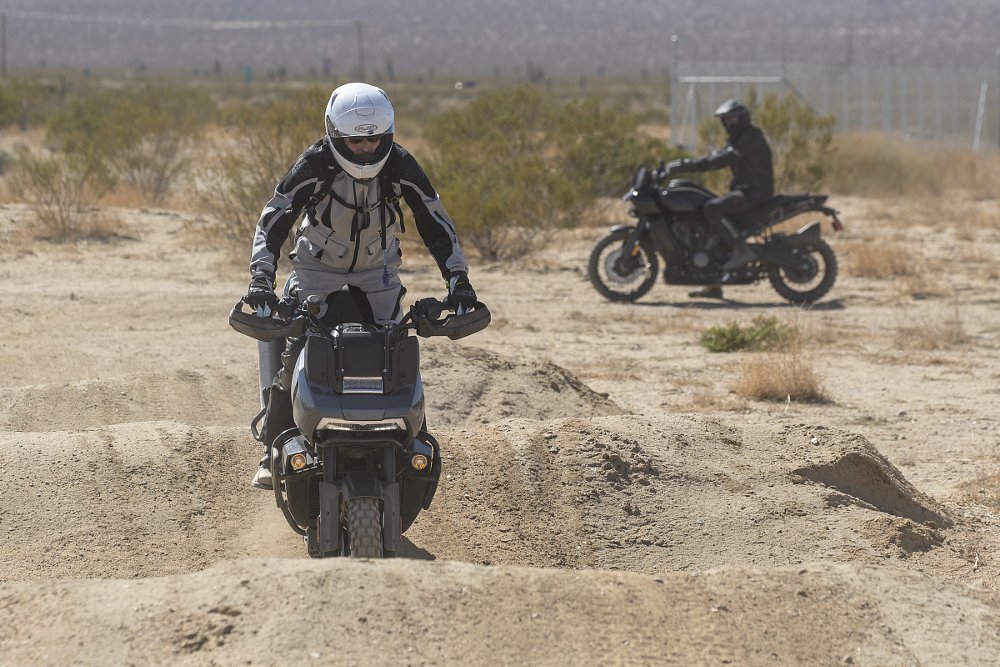
Was Jawbone Road named after a human jawbone?
The winding asphalt section of our road day ended with a few miles that really emphasized the joys of sport-touring on big ADV bikes. The road was paved (at first) but it was old, broken and patched asphalt with an occasional skiff of sand. The upright riding position, plush suspension, ABS and traction control worked in perfect concert.
The RawHyde instructors serving as our ride leaders warned us that the paved section ended with Jawbone Road, which they described as "a few miles" of graded fire road that was "a little sandy" at the bottom. When the asphalt ended, I dutifully stood up on the pegs, switched to Off Road mode and tried to forget the instincts I’d built over 50 years.
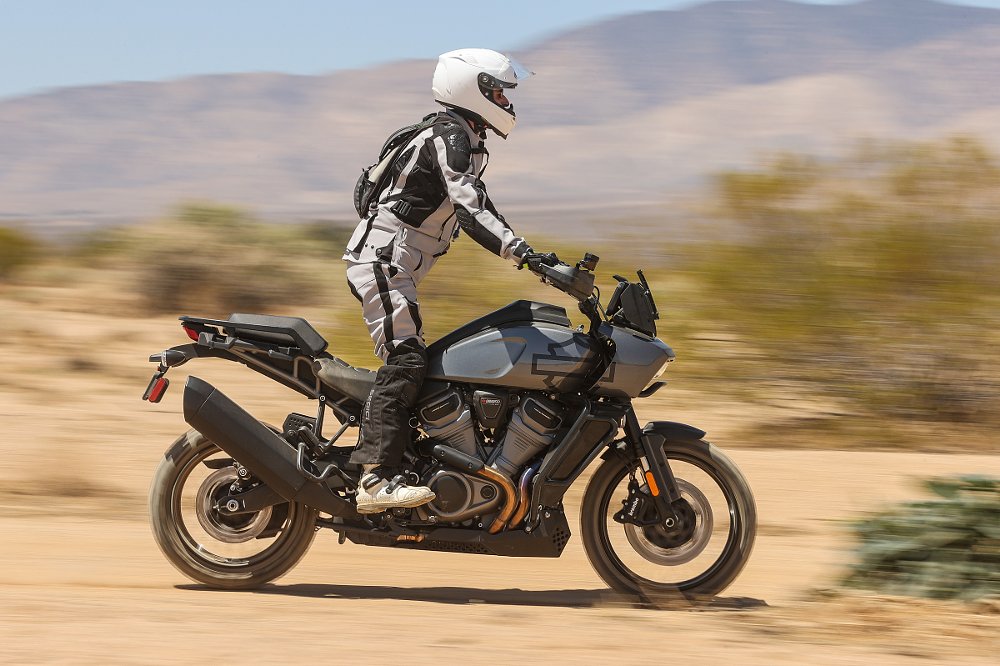
It was, let me admit, a road. A clutch of Harley employees followed us in a regular pickup truck. Spurgeon later assessed it rather airily as "about a three out of 10" on the off-road difficulty scale.
For me, I felt like my wheels were in line only when the bike switched from drifting right to drifting left, or vice versa. Maybe it might’ve been easier with dirt-biased tires. I didn’t have much mental bandwidth available, but I did, at one point, ponder whether the road had been named after a human jawbone. As in the remains of someone who didn't make it out of the canyon.
I was sure of two things: I needed everything I learned in my one-day RawHyde training course and all the Pan America’s rider aids to get down to sweet, sweet asphalt without dumping it. Kudos to both RawHyde and Harley-Davidson.
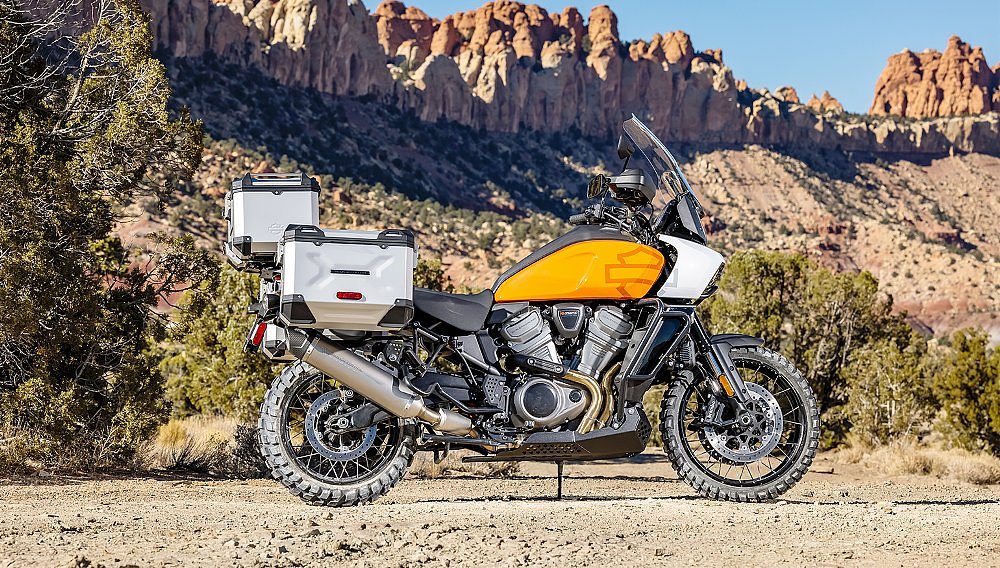
The view at sunset from ADV land
I was glad to have the experience of riding a 575-pound motorcycle through Jawbone Canyon, but I’m not eager to repeat it. I don’t think I was alone in thinking that either; there’s always a lot of macho posturing at these events, but when the ride leaders asked if anyone wanted to take an optional side trip up a gnarlier Jeep trail, not one hand was raised.
Don’t get me wrong: I’d love a bike I could ride from my house to fun and challenging loose-surface roads and trails, and then ride home again. But I would happily trade away 100 horsepower and Autobahn capability if it meant that I could also lose at least 200 pounds of weight.
So the Pan America is not my (great big) cup of tea. That said, deciding to launch an open-class ADV was an audacious, high-risk/high-reward strategy on Harley-Davidson’s part. The bikes it was benchmarked against all have strengths and weaknesses, but in its first crack at the adventure class, Harley-Davidson has built a motorcycle that is broadly competitive.
If you’re considering a big ADV bike for sport-touring — perhaps with an occasional gravel-road side trip — you now definitely have to put Harley-Davidson into the mix. When you factor in dealer support and the availability of adjustable ride height for a reasonable extra cost, it may be the best choice for a lot of riders.
| 2021 Harley-Davidson Pan America 1250 and Pan America 1250 Special | |
|---|---|
| Price (MSRP) | $17,319 (base), $19,999 (Special), $21,500 (as tested, not including the cost of the upgraded skid plate) |
| Engine | 1,252 cc, 60-degree, liquid-cooled, four-valve, V-twin |
|
Transmission, final drive |
Six-speed, chain |
| Claimed horsepower | 150 @ 9,000 rpm |
| Claimed torque | 94 foot-pounds @ 6,750 rpm |
| Frame | Steel trellis, aluminum midsection |
| Front suspension | Showa inverted 47 mm fork, adjustable for preload, compression, and rebound, semi-active option on the Special; 7.48 inches of travel |
| Rear suspension | Showa monoshock, adjustable for preload, semi-active option on the Special; 7.48 inches of travel |
| Front brake | Dual Brembo radial-mount calipers, 320 mm discs, ABS |
| Rear brake | Brembo floating single-piston caliper, 280 mm disc, ABS |
| Rake, trail | 25 degrees, 6.2 inches |
| Wheelbase | 62.2 inches |
| Seat height | 31.8 inches (laden with 180-pound rider) |
| Fuel capacity | 5.6 gallons |
| Tires | Michelin Scorcher Adventure, 120/70R19 front, 170/60R17 rear; (Optional: Michelin Anakee Wild) |
| Claimed weight | 534 pounds (base, wet), 559 pounds (Special, wet), 573 pounds (as tested) |
| Available | Now |
| Warranty | 24 months |
| More info | harley-davidson.com |

 Membership
Membership





